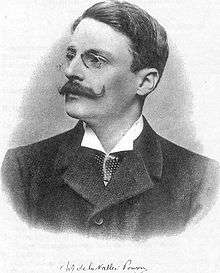Charles Jean de la Vallée-Poussin

Baron de la Vallée Poussin
Charles-Jean Étienne Gustave Nicolas Le Vieux, Baron de la Vallée Poussin (14 August 1866 – 2 March 1962) was a Belgian mathematician. He is best known for proving the Prime number theorem.
The king of Belgium ennobled him with the title of baron.
Biography
De la Vallée-Poussin was born in Leuven, Belgium. He studied mathematics at the Catholic University of Leuven under his uncle Louis-Philippe Gilbert, after he had earned his bachelor's degree in engineering. De la Vallée-Poussin was encouraged to study for a doctorate in physics and mathematics, and in 1891, at the age of just 25, he became an assistant professor in mathematical analysis.
De la Vallée-Poussin became a professor at the same university (as was his father, Charles-Louis-Joseph-Xavier de la Vallée-Poussin, who taught mineralogy and geology) in 1892. De la Vallée-Poussin was awarded with Gilbert's chair when Gilbert died. While he was a professor there, de la Vallée-Poussin carried out research in mathematical analysis and the theory of numbers, and in 1905 was awarded the Decennial Prize for Pure Mathematics 1894–1903. He was awarded this prize a second time in 1924 for his work during 1914–23.
In 1898, de la Vallée-Poussin was appointed as the correspondent to the Royal Belgian Academy of Sciences, and he became a Member of the Academy in 1908. In 1923, he became the President of the Division of Sciences.
In August 1914, de la Vallée-Poussin escaped from Leuven at the time of its destruction by the invading German Army of World War I, and he was invited to teach at Harvard University in the United States. He accepted this invitation. In 1918, de la Vallée-Poussin returned to Europe to accept professorships in Paris at the Collège de France and at the Sorbonne.
After the war was over, de la Vallée-Poussin returned to Belgium, The International Union of Mathematicians was created, and he was invited to become its President. Between 1918 and 1925, de la Vallée-Poussin traveled extensively, lecturing in Geneva, Strasbourg, and Madrid. and then in the United States where he gave lectures at the Universities of Chicago, California, Pennsylvania, and Brown University, Yale University, Princeton University, Columbia University, and the Rice Institute of Houston.
He was awarded the Prix Poncelet for 1916.[1] De la Vallée-Poussin was given the titles of Doctor Honoris Causa of the Universities of Paris, Toronto, Strasbourg, and Oslo, an Associate of the Institute of France, and a Member of the Pontifical Academy of Sciences,[2] Nazionale dei Lincei, Madrid, Naples, Boston. He was awarded the title of Baron by King Albert 1 of the Belgians in 1928.
In 1961, de la Vallée-Poussin fractured his shoulder, and this accident and its complications led to his death in Watermael-Boitsfort, near Brussels, Belgium, a few months later.
A student of his, Georges Lemaître, was the first to propose the Big Bang theory of the formation of the Universe.
Work
Although his first mathematical interests were in analysis, he became suddenly famous as he proved the prime number theorem independently of his coeval Jacques Hadamard in 1896.
Afterwards, he found interest in approximation theory. He defined, for any continuous function f on the standard interval [−1,1], the sums
- ,
where
and
are the vectors of the dual basis with respect to the basis of Chebyshev polynomials (defined as
- .
Note that the formula is also valid with being the Fourier sum of a -periodic function 'F' such that
- .
Finally, the de la Vallée-Poussin sums can be evaluated in terms of the so-called Fejér sums (say )
- .
The kernel is bounded () and obeys the property
- , if
Later, he worked on potential theory and complex analysis.
Selected publications
- Oeuvres, vol. 1 (Biography and number theory), 2000 (eds. Mawhin, Butzer, Vetro), vols. 2 to 4 planned
- Cours d´Analyse, 2 vols., 1903, 1906 (7th edition 1938), Reprint of the 2nd edition 1912, 1914 by Jacques Gabay, ISBN 2-87647-227-9 (deals only with real analysis).[3] Online:
- Integrals de Lebesgue, fonctions d´ensemble, classes de Baire,[5] 2nd edition 1934, Reprint by Jacques Gabay, ISBN 2-87647-159-0
- Le potentiel logarithmique, balayage et representation conforme, Paris, Löwen 1949
- Recherches analytiques de la théorie des nombres premiers, Annales de la Societe Scientifique de Bruxelles vol. 20 B, 1896, pp. 183–256, 281–352, 363–397, vol. 21 B, pp. 351–368 (prime number theorem)
- Sur la fonction Zeta de Riemann et le nombre des nombres premiers inferieur a une limite donnée, Mémoires couronnés de l Academie de Belgique, vol.59, 1899, pp. 1–74
- Leçons sur l'approximation des fonctions d'une variable réelle Paris, Gauthier-Villars, 1919,[6] 1952
Notes
- ↑ "Prix Poncelet". Comptes rendus hebdomadaires des séances de l'Académie des sciences, séance du 18 Décembre 1916: 791.
- ↑ http://www.casinapioiv.va/content/accademia/en/academicians/deceased/delavalleepoussin.html
- ↑ Porter, M. B. (1915). Review: Cours d'Analyse Infinitésmale, by Ch.-J. de la Vallée Poussin (PDF). Bull. Amer. Math. Soc. 22. pp. 77–85.
- ↑ Porter, M. B. (1925). Review: Cours d'Analyse Infinitésimale, Tome I, by Ch. J. de la Vallée Poussin (PDF). Bull. Amer. Math. Soc. 31. p. 83.
- ↑ Carmichael, R. D. (1918). Review: Integrals de Lebesgue, Fonctions d'Ensemble, Classes de Baire, by C. de la Vallée Poussin (PDF). Bull. Amer. Math. Soc. 24. pp. 348–355.
- ↑ Jackson, Dunham (1922). Review: Leçons sur l'approximation des fonctions d'une variable réelle, by C. de la Vallée Poussin (PDF). Bull. Amer. Math. Soc. 28. pp. 59–61.
See also
External links
- Biographie Universelle, by Didot.
- O'Connor, John J.; Robertson, Edmund F., "Charles Jean de la Vallée-Poussin", MacTutor History of Mathematics archive, University of St Andrews.
- Obituary